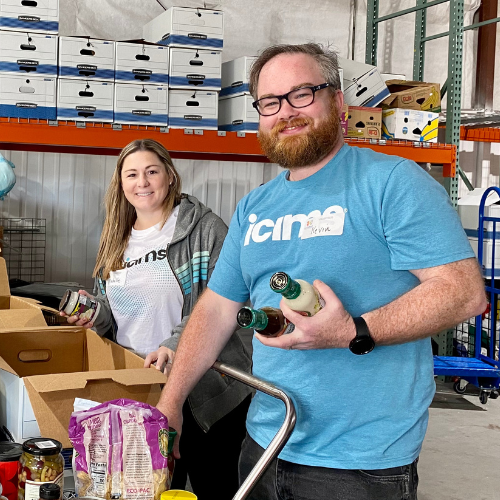- Solutions
- Products
- Community
- Resources
- Company
Create incredible candidate experiences that communicate your brand, mission, and values with recruitment marketing solutions.
Learn moreCommunicate effectively and efficiently with the candidates that can drive your business forward.
Learn moreSelect the right candidates to drive your business forward and simplify how you build winning, diverse teams.
Learn moreHelp your best internal talent connect to better opportunities and see new potential across your entire organization.
Learn moreCommunicate collectively with large groups of candidates and effectively tackle surges in hiring capacity.
Learn moreAccess tools that help your team create a more inclusive culture and propel your DEI program forward.
Learn moreRebound and respond to the new normal of retail with hiring systems that are agile enough to help you forge ahead.
Learn moreAccelerate the hiring of key talent to deliver point of care and support services that meet and exceed your promise of patient satisfaction.
Learn moreAttract and engage candidates with technical competencies, accelerate hiring for much-needed skills, and advance expertise within your valued workforce.
Learn moreSimplify how you recruit finance, insurance, and banking candidates with a unified platform built to match top talent with hard-to-fill roles.
Learn moreYour business strategy depends on your people strategy. Keep both in lockstep with the iCIMS Talent Cloud.
Learn moreBuild an engaging, high-converting talent pipeline that moves your business forward.
Learn moreDeliver the innovation your talent team needs, along with the global scale and security you demand.
Learn moreDeliver tailored technology experiences that delight users and power your talent transformation with the iCIMS Talent Cloud.
Learn moreThe #1 ATS in market share, our cloud-based recruiting software is built for both commercial and large, global employers.
Learn more Talk to salesAttract the best talent for your business with powerful, on-brand career websites that excite candidates and drive engagement.
Learn more Talk to salesBuild talent pipelines, engage candidates with multi-channel marketing campaigns, and use machine learning to automatically surface the right talent for the job.
Learn more Talk to salesEmpower candidates with automated self-service, qualification screening, and interview scheduling through an AI-enabled digital assistant.
Learn more Talk to salesSimplify employee onboarding with automated processes that maximize engagement and accelerate productivity.
Learn more Talk to salesCompliment your sourcing and engagement efforts with award-winning lead scoring and advanced campaign personalization.
Learn more Talk to salesImprove employee experience, retention, and reduce internal talent mobility friction with the iCIMS Opportunity Marketplace.
Learn more Talk to salesVerify skills with game-changing levels of automation and simplicity to improve the quality of hire at scale.
Learn more Talk to salesModernize, streamline, and accelerate your communication with candidates and employees.
Learn more Talk to salesTransform the talent experience by showcasing your authentic employer brand through employee-generated video testimonials.
Learn more Talk to salesGet robust analytics that help you make sense of your data and illuminate your talent pool.
Learn moreSimplify recruiting, dynamically engage talent, and reduce hiring bias with job matching and recruiting chatbot technology.
Learn more Talk to salesGet exclusive intel on industry and market trends along with expert one-on-one advice.
Learn more Talk to salesThe #1 ATS in market share, our cloud-based recruiting software is built for both commercial and large, global employers.
Learn more Talk to salesAttract the best talent for your business with powerful, on-brand career websites that excite candidates and drive engagement.
Learn more Talk to salesBuild talent pipelines, engage candidates with multi-channel marketing campaigns, and use machine learning to automatically surface the right talent for the job.
Learn more Talk to salesEmpower candidates with automated self-service, qualification screening, and interview scheduling through an AI-enabled digital assistant.
Learn more Talk to salesSimplify employee onboarding with automated processes that maximize engagement and accelerate productivity.
Learn more Talk to salesCompliment your sourcing and engagement efforts with award-winning lead scoring and advanced campaign personalization.
Learn more Talk to salesImprove employee experience, retention, and reduce internal talent mobility friction with the iCIMS Opportunity Marketplace.
Learn more Talk to salesVerify skills with game-changing levels of automation and simplicity to improve the quality of hire at scale.
Learn more Talk to salesModernize, streamline, and accelerate your communication with candidates and employees.
Learn more Talk to salesTransform the talent experience by showcasing your authentic employer brand through employee-generated video testimonials.
Learn more Talk to salesGet robust analytics that help you make sense of your data and illuminate your talent pool.
Learn moreSimplify recruiting, dynamically engage talent, and reduce hiring bias with job matching and recruiting chatbot technology.
Learn more Talk to salesGet exclusive intel on industry and market trends along with expert one-on-one advice.
Learn more Talk to salesHow a beloved restaurant hires 40,000+ annually with a great candidate experience.
Learn moreThousands strong, our global community of talent professionals includes creatives, innovators, visionaries, and experts.
Learn moreTogether we’re creating the world’s largest ecosystem of integrated recruiting technologies.
Learn moreExplore our network of more than 300 certified, trusted third-party service and advisory partners.
Learn moreUncover unique market insights, explore best practices and gain access to talent experts across out library of content.
Get resourcesExpert guidance about recruitment solutions, changes in the industry, and the future of talent.
Learn moreStay up to date with the latest terminology and verbiage in the HR software ecosystem.
Learn moreEmployers everywhere improve hiring efficiently and save money using iCIMS. Estimate the potential business value you can achieve.
Learn moreDive into the Class of 2023 Report highlighting this cohort’s expectations and where employers are willing — and able — to meet them.
Watch nowPartner with iCIMS to build the right strategies, processes, and experience to build a winning workforce.
Learn moreExpert guidance about recruitment solutions, changes in the industry, and the future of talent.
Learn moreThe iCIMS Talent Cloud delivers a secure, agile, and compliant platform designed to empower talent teams, job seekers, and partners with advanced data protection and privacy.
Learn moreView press releases, media coverage, and the latest hiring data. See what analysts are saying about iCIMS.
Learn moreiCIMS is the Talent Cloud company that empowers organizations to attract, engage, hire, and advance the talent that builds a winning workforce.
Learn moreGet to know the award-winning leadership team shaping the future of the recruiting software industry.
Learn moreWe believe the future of work isn't something that "happens" to you. It's something you create. We actively create the future of work with our customers every day.
Learn moreiCIMS is committed to being a responsible and ethical corporate citizen, which is why Environmental, Social and Governance (ESG) initiatives are strategic imperatives.
Learn moreStreamline your tech stack and take advantage of a better user experience and stronger data governance with ADP and the iCIMS Talent Cloud.
Learn moreThe combined power of iCIMS and Infor helps organizations strategically align their business and talent objectives.
Learn moreOur award-winning partnership with Microsoft is grounded in a shared desire to transform the workplace and the hiring team experience.
Learn moreOur partnership with Ultimate Kronos Group (UKG) supports the entire talent lifecycle by bringing frictionless recruiting solutions to UKG Pro Onboarding.
Learn moreLet’s get in touch. Reach out to learn more about iCIMS products and services.
Learn more

As we recovered from the 2008 downturn, we saw years of high M&A activity, and then the uncertainty of the pandemic brought everything to a grinding halt.
Faced with the new future of work, leaders continue to look inward to reorganize their structures for greater efficiency and new revenue drivers. It begs the question: will the urgency of workplace transformation become the new driver of deals?
The short answer: Likely.
The need to “transform digitally, innovate new business models,” and “accelerate commercialization of the most promising technologies” was cited as an “opportunistic hotspot” in a recent M&A Leadership Council survey. You can easily see that in the tech world where giants are eyeing up start-ups, such as Amazon’s acquisition of autonomous driving start-up Zoox.
Even though deal activity is slowing down (remote due diligence being one of the many factors), 57% of respondents said they plan to move forward on M&A deals, with 49% intending to buy distressed companies. Makes sense, especially for industries like tourism that have been hit hard by the pandemic. Strategic partnerships in hospitality continue to pop up including this three-way venture deal in Nashville.
We’ve written about navigating HR and recruitment during M&A (you can find that article here), and now it’s time to dig deeper into what happens behind the scenes to bring together people, culture, and workflows.
We sat down (virtually) with two of our partners, Elaine Orler of Talent Function and Joe Stewart of Synchro Talent Technology Services, to hear about their M&A consulting experiences.


As CEO and founder of Talent Function, Elaine has been developing and implementing talent acquisition strategies and solutions since 1993. Her consulting firm helps organizations design their TA framework, drawing from her deep expertise in competitive talent strategy models, process consulting, and HR data and analytics.


CEO and founder of Synchro Talent Technology Services, Joe’s firm helps organizations maximize the effectiveness of their people, process and technology through customized solutions to bridge the gap between current state talent technology capabilities and the strategic needs of the business.
Elaine Orler: Well to start, a lot of things are declared as a merger, but they’re still an acquisition. So, for us, we’ve got to figure out what the scenario really is because it changes the way in which we approach it and changes the direction they’re going to go in. The scenario which is the hardest one to work on is when it is declared a merger but it’s really an acquisition, because you’re dealing with two different messages.
Joe Stewart: It’s almost always an acquisition. Even if it is a merger. Know where the upper hand is.
Joe: It’s an easier message to digest when leadership isn’t just leading from an office somewhere far away. They are there with the team and working directly with the users. I deploy my whole team on site to make introductions, so we don’t feel like some foreign invader. When you respect the existing culture, you make everybody feel like they’re part of the same project.
Elaine: What the business will represent as a consolidated structure is typically done within marketing and employee communications. But then there’s the recruitment brand and you need to determine how you present yourselves as a unified organization.
Joe: And this is important because culture ties into adoption.
Elaine: You present it as a chance for them to take a pause and decide if there’s a better way to do the work and if that’s the best way for the organization going forward. Every layer gets peeled back so we can discuss: What are the preferences? What are the best practices? And how do you want to present yourself going forward?
Joe: And you keep it on track with a structured plan that is not overly ambitious and with timelines that you won’t miss. Because as soon as you start missing timelines, you take dings to your credibility and the attitude really shifts. And the plan should leave some room to adapt when things are not going as expected.
Elaine: Core systems are defined at the executive level, such as the finance system and sales system. There is usually some time to operate these separately until they can make all those pieces come together. But for talent acquisition, they’re trying to quickly operate under the new brand, so we tend to see a more aggressive effort to get that consolidated as fast as possible.
Joe: We talk first from a more conceptual perspective. It’s a discussion of, ‘This our hiring process and this is how it differs from yours’ and where there may be some things missing. Then we identify whether those are actual needs or perceived needs and where those needs stand after a full-on tech integration is completed.
Elaine: In our future-state workshops, we map out the three user journeys, one of them being the candidate. If they applied at the company before, are we going to ask them to reapply? How are they going to feel about this new organization? There’s a whole lot of devil in the details on all those pieces.
Joe: I do have clients that come to me with that way of thinking and I will say that generally speaking they undo that way of thinking within 12 to 18 months when the recruiting function realizes it doesn’t have the tools it needs. Recruiting, thankfully, has enough of a voice in the organization to keep that function separate from the rest of the HR system.
Elaine: It’s also getting the folks in the room to understand that the future doesn’t mean getting to the top of the mountain right away. It means getting off our islands and getting on the mainland. Then, we see where we can go from there. So, it’s determining what’s the best platform for being on the mainland.
Elaine: It all depends. I’ve worked on timelines anywhere from 90 days to three years.
Joe: I would say the sweet spot is around 12 to 18 months with a well-thought-out plan. It’s also setting a clear expectation that this is going to be 85% to 95% right and that we have the room to make changes after 30, 60, 90 days if it’s warranted.
Joe: While these events can be stressful at times, mergers and acquisitions also provide TA with an opportunity to shine. Make the most of it!
Elaine: My advice would be to find ways to contribute and be involved. There is always a fear component to change. One of the best opportunities is to lean into change and find ways you can adapt to a new normal.
and receive free tips on how to attract, engage, hire, & advance the best talent.





